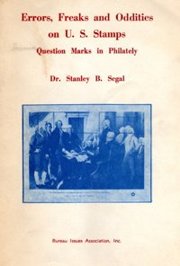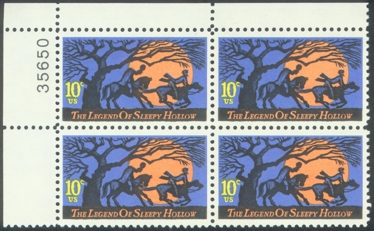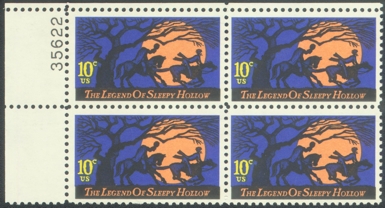
EFOCC Home
Resources
The EFO
Collector
Collector
Auction
Honor Roll
EFOCC History
Club Business
Membership
Buyers/Sellers
Service Providers
Service Providers
Member Login

EFOS for Sale
 |
| APS Affiliate #103 |
 |
 |
| ATA Chapter #94 |
| Click here for a printer friendly version of this essay. |
56. Color variations: Stamp designs used over long periods of time often can be found with differing shade varieties of their basic colors. The properties of the ink components can change, as can the quality and properties of the paper purchased by the printer. Those factors can affect the printed colors. New printing equipment, using the same plates and ink, also can result in shade and color-intensity differences. Unless pronounced, these shades are relegated to minor status and, though avidly collected by many, have little additional value.
The advent of photogravure printing in the late 1960s brought a whole new class of color varieties. Gravure is based on the sequential printing of four basic colors in carefully planned dot patterns, one on top of the other, to produce the impression to the human eye of every color of the rainbow. It produces much more colorful stamps. But it also causes collectors to notice shade differences more than ever before because a small difference in the inking of one color plate often has a dynamic effect on the final colors produced. Expertizers frequently see photogravure stamps submitted as missing-color candidates, when they are only a light print of one of the four basic colors. Thus, there is a range of normal for most photogravure stamps, and a stamp has extra value only if it falls outside that range.
Another group of color variations evolved from the Giori process, in which up to three colors are printed from a single plate. The ink is in wells that are one above the other at one end of the press. An inking-in roller takes the ink from its trough and applies it to its discrete portion of the plate. The excess ink is wiped off, and the stamps are printed. With such a complicated piece of equipment, many things can go wrong. Ink from one trough can fall into the trough below, leaving spots of the wrong color in the middle of the correct color. If a spill is large, an entire color can be changed as the two inks mix. If the wiping of the plate is not done carefully, one ink color can be wiped into the area of another. This is called an "ink bleed" or "contamination." If the inking-in roller is not properly aligned with the plate, design elements may appear partially the wrong color, depending upon how much the roller and plate are out of alignment. The alignment problem can be horizontal or vertical.


Type 56: Light and dark background blue colors are due to differences in ink application (Scott 1548).




Type 56: Four different shade varieties of the Presidential 4¢ Madison (Scott 808) that was produced over 16 years. It is characteristic of the Presidential series that color changed over time as production equipment and ink formulations changed.

Type 56: This is an example of the Giori misaligned inking in roller phenomenon, leaving the Flag severely discolored (Scott 1895).
| Previous: Excess ink between stamps | Color variations | Next: Tagging varieties |
| Table of Contents | Freaks |
John M. Hotchner
Errors, Freaks & Oddities
The EFO Collector
The Archives
John M. Hotchner
EFO Corner
The Columns
from Linn's
from Linn's
Articles By
Wayne Youngblood
AG
Files
Ryskamp
on
Computer-Vended Postage
Not
quite
EFOs